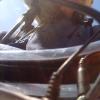Search the Community
Showing results for tags 'ADR'.
-
Hiyas! It’s truly been a while since I posted anything here it seems.. Anyway, nowadays I work in radio and there's just a different approach to everything, basically. One thing is background noise for example. Journalists like to keep things realistic, and therefore there's not a lot of recording separate backgrounds to add on later. If they want bg noise in their speakers/VOs they just record them in the environment they want. Sometimes at least. Most (99,9%) of the time they don't want the noise. Anyway. The other day this guy had made a similar VO, recorded in the street. But he got some facts wrong and needed to replace a few words. So he went in the studio thinking he could shoehorn the words in there somehow, failed miserably of course. Then we decided that he should do it over, but he wanted to keep "authenticity" of course. So we just took the handheld recorder he'd used in the street, in the studio, and played back another street noise in his headphones. That way he could sort of hear things the way he'd heard them when he did the original recording. Now, that got me thinking of how this could be used in ADR. Most of the time, actors will deliver a lot less volume and intensity than on set. I mean, I've spent hours on just trying to get an actor to actually louden his voice in order to get it right. Maybe hearing the background from the scene would help in that? I guess leakage from the headphones would be a thing, but it'd be covered by the real BGs later on. Dunno, is this already being used? I don't think I've come up with an amazing new thing here, just reality checking I guess. I know for a fact it's not being used at all in Sweden (that I know of).I used to love doing exterior ADR, just because it sounded a lot more like the real thing from the get go. It was hard to get there, but totally worth it in terms of performance. All the best to all of you!
-
I recently started doing post production mixing for a company. We mostly do commercials and short corporate videos, most of which require a VO. When available, the VO talent uses our booth and we record here. But often times we use someone out of state, which we have an ISDN line for. However, being a bit young, I've never done a VO session over ISDN and I'm not sure the steps to take in order to get things up and running. I'm hoping someone would be willing to write out a simple step by step guide to setting up a VO session over ISDN, assuming of course that there are some universal steps to be taken, that aren't unique to each studio setup. If thats the case, any info would be a tremendous help. Also I've read a little about Source Connect being a better/newer option, but it can also be quite buggy. Is that the case yet, or is ISDN still more stable?
-
Hello - I know this is slightly OT but I figured the good people here will have lots of experience with this mic. I have an ADR session tomorrow that used an MKH40 on set, and I need to match that as closely as possible. I've never actually used the 40, so I was wondering what you guys would think would match in there the best. I have easy access to: Sennheiser 416, 415, MKH50, MKH60 Neumann KMR81, KMR82 Schoeps MK41, CMIT5U Sanken CS-3e Thanks all! -Mike
-
VocALign is the unique audio software solution for music and audio post that will adjust the timing of one audio signal to match the timing of another. VocALign's unique ability to align two signals enables it to be used creatively to take guide or even "live" tracks and create performances with perfectly aligned overdubs. This outstanding software gives users perfectly aligned double-tracked vocals, tight backing vocals, easy re-grooving of recorded vocals for remixing and shorter overdub sessions. Users also have the ability to choose the best rhythm and pace for a specific vocal, or even lay down the required tempo pattern for the artist. For post-production, VocALign will automatically edit a line of replacement dialog so that it aligns with the dialog recorded with the original film or video. The artist can concentrate on performance and the result is perfectly lip-sync'd dialog, or more convincing foreign language dubs. VocALign is a truly amazing tool, which reduces the time taken to re-record dialog or vocals, saving money by drastically reducing production and studio time. Artists can now concentrate on performance and not sync during overdubbing sessions. For more information: http://www.synchroar...ocalign-project
- 2 replies
-
- ADR
- Synchronization
-
(and 2 more)
Tagged with:



